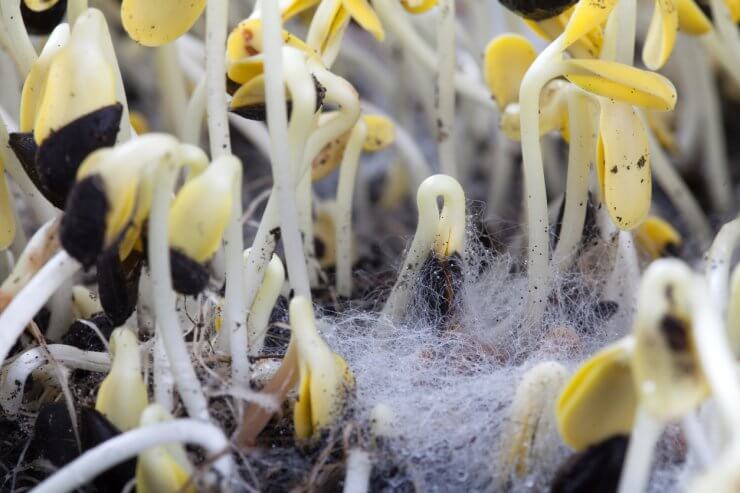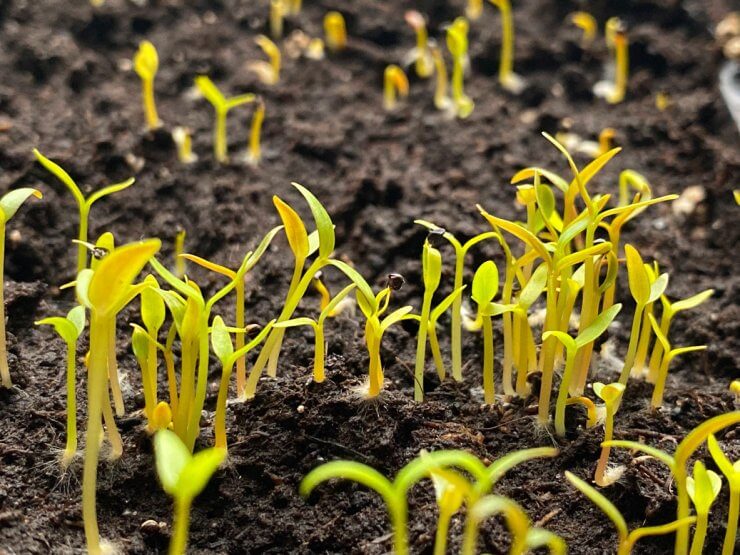
When it’s the seed-starting time of the year, it feels like a fresh start, doesn’t it? You fill your pots and seed trays with sterile soil, baby your seeds until they sprout, and dream about how your season is going to turn out. But sometimes over-babying your seedlings can have its consequences. And in that regard, let’s talk about mold. More specifically, let’s talk about white mold on seedlings. I’ll start with good news; most white mold won’t hurt your seedlings. The bad news? The conditions that cause mold make the environment ripe for other, more problematic situations.
All mold thrives in damp, warm environments. Like my brain after chasing a toddler all day long. (Did I write that out loud?) But guess what else thrives in damp, warm environments? Seeds! Generally speaking, that white mold on seedlings in your garden isn’t an emergency. You do, however, want to take care of it.
Discover 7 top tips for growing, harvesting, and enjoying tomatoes from your home garden—when you access the FREE guide The Best Way to Grow Tomatoes, right now!

What to do about white mold on seedlings and other plants in your garden
Okay, so white mold on seedlings isn’t the end of your plants. Take a breath, thank the fates, and let’s figure this out.
White mold comes from any number of sources. It’s common in packaged soil, and it may be in your garden soil. The chances of avoiding it entirely are pretty slim. That’s okay. The white mold itself may be a bit unsightly, but it’s not going to hurt your seedlings right away. One thing to watch out for is that as the mold spreads, it becomes more difficult for your plants to absorb sunlight. And since your seedlings have so little leaf space, this can be an issue.
The potentially bigger problem, however, is that white mold may not be the only mold hovering around your seedlings. Those same damp conditions are ideal for root rot, damping off, and other diseases. I’m sure I don’t have to tell you that these are bad.
What can you do? A lot, as it turns out. There are some things that mold does not like. And many of them are within your power to provide.
1. Sunlight. Sunlight is nature’s mold removal system. If you can move your seedlings around, that could be enough to solve the problem.
2. Airflow. As fresh air circulates around your seedling, it helps dry the soil and prevents mold spores from settling. If your seedlings are still indoors and covered, it’s time to remove the cover. However, we don’t want to make abrupt changes to the environment, so do this a little at a time for a few days until the cover is completely removed. This is true for outdoor seedlings, as well.
3. Airflow part 2. If you find white mold on seedlings indoors and they’re already uncovered, use a small fan to help circulate air in the room. Don’t blast your seedlings with it; just turn it on low and point it in their general direction.
4. Cinnamon. If you find white mold in the soil, sprinkle some cinnamon around your seedlings. The spice can help limit the growth of bacteria, and as a bonus, it also helps repel several garden pests.
5. Neem oil. Neem oil is a naturally occurring and darn effective insecticide, but it doubles as a preventative for white mold.
6. Decrease watering. Since moisture and warmth are ideal for mold, it makes sense to decrease the amount of moisture in the soil around your seedlings. You’ll have to use your best judgment because you don’t want parched seedlings. A combination of a bit less moisture, more sunlight, and some increased airflow should be enough to limit or reverse the growth of mold.
7. Sanitize your equipment. Technically, this happens long before the appearance of white mold on seedlings. For that matter, it happens before you even start your seeds. When you sanitize your seed trays and tools before you begin planting, you set yourself and your seedlings in the best possible position to avoid problems with mold. That’s not to say you still won’t have to deal with white mold, but at least you do what you can to limit its impact.
Have you had issues with white mold on seedlings in your garden? How did you solve the problem?
Discover 7 top tips for growing, harvesting, and enjoying tomatoes from your home garden—when you access the FREE guide The Best Way to Grow Tomatoes, right now!





I think I have a white mold on the leaves of my squash.
HELP.
I can’t find a remedy anywhere on this site, have I missed it?
Have you looked up powdery mildew? https://foodgardening.mequoda.com/daily/watering-irrigation/how-to-water-squash-and-avoid-powdery-mildew/ If it looks like that, it’s best to cut your losses on the affected leaves because it will continue to spread. Your plants can still make squash if you let it go, they’ll just start to decay a lot faster.